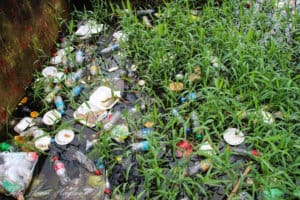
Then I noticed the handmade sign saying “Prohibited to throw rubbish”.
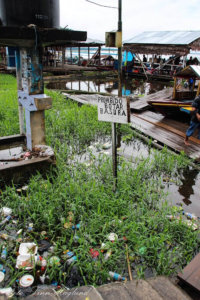 Apparently, I wasn´t the only one to see the sign too late.
Apparently, I wasn´t the only one to see the sign too late.
As I was daydreaming on the boat looking forward to entering the deep rainforest, looking at the river, I noticed that our guide flicked his cigarette butt off the boat as he finished smoking.
I was thrown back in memories from when my friend and I were sailing the Whitsundays in Australia back in 2006. We had been well instructed by the boat crew that throwing cigarette butts into the ocean was strictly prohibited. In fact, there was quite a harsh penalty for those caught doing so: a spoonful of Vegemite. Whoever is not Ozzie hates Vegemite. And those who have been to Australia, know exactly what I´m talking about. It´s still a myth to me how every single Australian loves this awful spread.
I remember saying “nooooooo” as I saw the cigarette butt fly in slow motion from my friend’s fingertips into the ocean, trying quickly to cover up my expression so that nobody else would notice what she had just done. Too late. Just minutes later she was in the toilets spewing up what she could of that awfulness she had had to swallow.
That was enough for me to not make the same mistake. In fact, the lesson from the boat crew on that sailboat in the Whitsundays made me completely stop throwing cigarette butts on the ground until I stopped smoking eight years later.
The crew made me aware of the effects throwing a cigarette butt has on the planet. Besides the fact that animals can eat them, they can take up to ten years to decompose! Ten years is a lot of time, and I definitely think all tourist guides across the world should learn about this in their studies.
Ok, the cigarette butt was not the main point of this story or the saddest part of my trip to the Amazon. It was just an observation on the road.
Back to the Amazon. During our days there, our guide took us to different places along the river to show us animals and teach us about Ayahuasca, to see the sunset and swim in the Amazon river. We even visited a tribe that earned their living dancing for tourists and selling bracelets while you could see they hated what they were doing, and shoved us out to get ready for the next group of tourists as they understood they couldn´t sell more. All the typical tourist things. But I didn´t go to the Amazon only to see those things. I wanted something unique.
I did see something unique, though. We were lucky to see pink river dolphins as we cruised along the Amazon river one day. I wish I’d had a better camera!
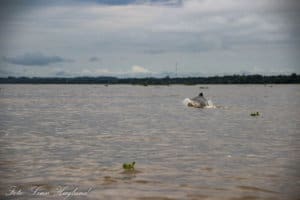
Anyway, I wanted to see the real rainforest and wild animals! Except for the river dolphins cruising by our boat that day, we only saw animals in captivity.
Most of the animals were free to move around, but humans made sure they were kept to a certain area so that tourists could take their pictures. One place had a poor anaconda of about three meters. The skin around her head was all damaged by all the people that held her head firm (a bit too hard because it is an anaconda, right, and you wanna make sure she doesn´t eat you), for photos every day. Of course, I saw this as I held her in front of the camera myself. I regret I did it. She slipped away after the photoshoots to get some space up in a tree, and I felt a bit empty looking at her. This was her life. Definitely not a life for an anaconda.
Did I really want to see an anaconda that way? No. Not really. It would be cool seeing one swimming past our boat. But not too big, cause I´m a bit of a coward and quite scared of big fat snakes that can strangle me and the whole boat to death. I did see a few unlucky minutes of the movie Anaconda when I was fifteen, and that image is what I´m stuck with. Damn photographic memory.
On our last day, we asked our guide to take us for a hike in the rainforest, instead of doing whatever touristy he had planned. He didn´t really understand why we didn´t want to visit another “tribe” that had a standard show made for tourists and probably also sold bracelets and were tired of tourists, but finally, he agreed to take us.
Because of the high tide (our bungalows only had access by boat) we couldn´t walk anywhere around the bungalows. The guide decided to take us on a boat trip to his village, and from there we would walk into the “rainforest”. My expectations were high. I had been to both Daintree rainforest and the Maya rainforest and was ready for what I thought would be even more intense. I got so disappointed. The tallest trees weren’t much taller than a banana palm tree and visibility from the path – kilometers? Well maybe not, but I am not very tall and could see far, so it means it wasn´t exactly rainforest we were walking through.
For sure, there were lots of different tropical plants and flowers, and some stunning enormous butterflies in bright blue and yellow that caught my eye, but no rainforest. Our guide was eager to explain and show us the different species of plants. The most exciting thing I found was the machete he was carrying around.
Then. After a couple of hours walk, I found the source of the deforestation of what the boy called “la Selva”, the rainforest. A sawmill. Massive tree trunks were covering the river. Barefoot men without any form of protection or helmets were walking on top of the huge rolling trunks and securing them together with steel wires.
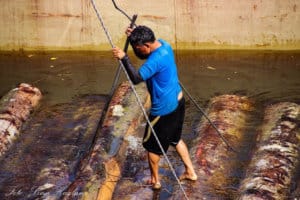
In shock, I looked at our 20-year-old guide. He smiled proudly and explained that he used to work at this sawmill before he started studying to become a guide. His dad and uncle worked there as well. There were accidents once in a while (I am not surprised, looking at what they wore at work), but this was the best-paid job the villagers had and was very good for the villages’ economy. It was because of the job at this sawmill that this boy standing in front of me proudly could afford to study to become a tourist guide.
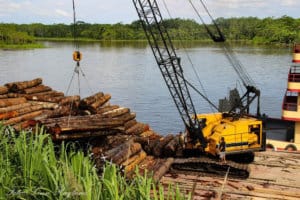
According to our guide, the only disgrace was the river police that would burn all the wood if they caught the boats transporting the wood along the river.
Does this sawmill run illegally together with thousands of other businesses cutting down trees along the Amazon river? We were just standing in the middle of it, and hearing a locals’ view of the business.
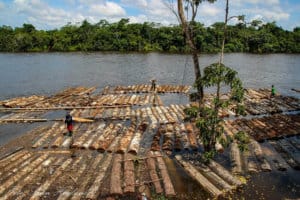
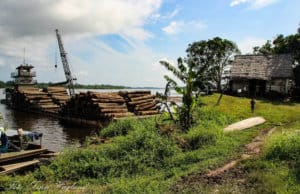
Mafia, drug dealers and a corrupt state all protect the illegal businesses, and laws are made to make it easy for the illegal loggers to transport the wood.
Three years later and I´m still stuck with this experience as the strongest impression from Peru. I´m glad I didn´t experience the deep rainforest, not on this trip anyway. I consider myself lucky for our guide taking us to his old workplace. It made me wake up and see firsthand how money impacts everything. It left me wondering what I, as an individual can do to make a difference.
How do you think travelers can impact the deforestation and the littering of the Amazon? Have you had a similar experience? I would love to know in the comments!
Read next: 15 Epic Peru off the beaten track destinations
[instagram-feed]
Your post was a bit sad to read and yet, I can relate. Things are starting to change in Peru but it’s a slow process. Protection of the environment is simply not important in the Amazon region yet. It’s a bit different in the Andean regions and things are getting a bit better in Lima, too. However, I also see that many Peruvians simply don’t care and just throw their waste everywhere. There are small companies who engage in eco-tourism, as visitors we should use them. Well, I hope you’ll get another chance to visit the Peruvian rainforest and will have a better experience then.
Hi Daniela, thank you for sharing your knowledge. It is good to know that parts of the country are getting better at protecting the environment, then the rest will hopefully follow soon. Anyhow, it is a long process for any country, and especially when it comes to educating people. I love that you mention that some small companies are engaged in eco-tourism, I will look for those on my next visit to the country. I must say, that even though I had a bit of a shocking eye-opener in the Amazon, I had some amazing travel experiences in Peru, and can’t wait to go back.